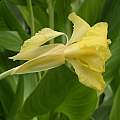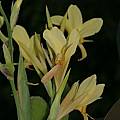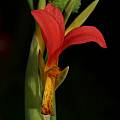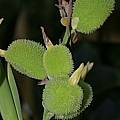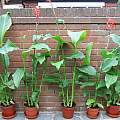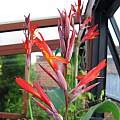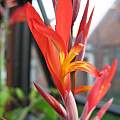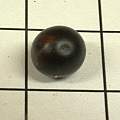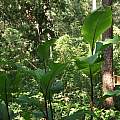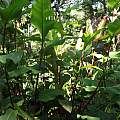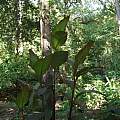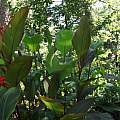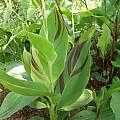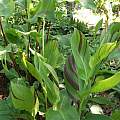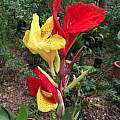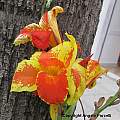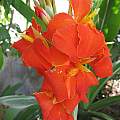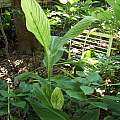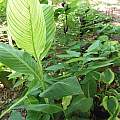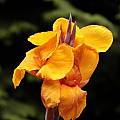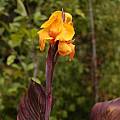The genus Canna L. is the only member of its family, the Cannaceae. It is a member of the order Zingiberales (which includes gingers, bananas, heliconias, and more) and may be closest to the Marantaceae (Prayer Plants). Species are native from the southern US through Central America to extreme southern South America. All have large rhizomes and grow as herbaceous perennials. Although known since pre-Linnean records, the plants were first brought into cultivation in the early 1800s. By the end of the century French and Italian hybridizers had developed a range of large flowered hybrids (also called orchid-flowered or Italian cannas). In the early decades of the 1900s, tropical gardens using large cannas as focal plants were immensely popular. These formal Canna beds may still be found in municipal parks.
Seeds should be scarified before sowing which greatly increases their germination. The key is finding the right pair of pliers for the job - a pair that will allow you to firmly hold the seed with one side exposed to the wrath of the mill bastard. With a sharp file and a firm grip, it only takes one or two strokes to expose the light colored endosperm (from Stephen Hopkins). Once scarified, the seeds can be soaked in warm water overnight and sown in a well-drained mix. Seed germination can start indoors in the winter if you live in a cold area. Keep the seedlings growing indoors until weather permits growing outside. Beware of root mealy bugs which seem to like Canna seedlings best. They should flower in their first year if conditions are right. Seeds can be stored at room temperature for many years. Bill Richardson reported that seeds collected in Queensland, Australia, stored in a drawer for 5 years had 100% germination.
Care is generally easy, but mostly they are only reliably hardy in Zone 7 and warmer, where they can be grown all summer and mulched lightly in winter. In colder climates the rhizomes must be dug after the first frost and stored around 50 °F (10 °C). Adaptability to winter storage varies widely and some are extremely easy to winter over, while others are temperamental and weak, easily lost if not kept to perfection. They grow best in damp, rich, high humus soils. Some may be grown all summer submerged in a few inches of water. In general they are greedy feeders. Much of the information for this wiki page supplied by Jim Waddick.
Canna flaccida Salisb. is a mostly aquatic species with yellow flowers with reflexed petals. It is native to the southeastern United States. Height range: 3-6 ft. Photo by Alberto Grossi.
Canna glauca L. is another mostly aquatic species with very narrow glaucous foliage and upright yellow flowers. It is found in southern Florida, parts of the Gulf Coast, and down through Central America. Height range: 3-6 ft. Photo by Alberto Grossi.
Canna indica L. is the hallmark of the species found throughout the American tropics in many different forms. Typically this plant will have a modest stature (6 ft) and small red terminal (upright) flowers, but it has been found with a wide range of colors, shades, and patterns from red, through orange to mostly yellow. A common name is 'Indian shot plant' which derives from the musket ball nature of the seed, and from 'West Indies' as a general term for America. Photos by Alberto Grossi.
Photographs by David Pilling, of plants grown in a greenhouse from seed sown in April, flowering at the end of July the same year, shown against a 5 foot high wall and seed on a 10 mm grid.
Photographs by Lin Grado, Wood County, Texas, demonstrating that this species can succeed in shade. The soil here is acid, sugar sand, improved with compost and alfalfa tea. Photos 4 and 5 are of variety 'Purpurea'.
Canna 'Cleopatra' is also known as 'Yellow King Humbert'; flowers are red and yellow; leaves mixed green and red. Photographs by Lin Grado.
Canna 'Italia' was the first selected hybrid made from C.L. Sprenger in 1893, from a batch of seedlings obtained crossing Canna 'Madame Crozy' (a French canna) with Canna flaccida. It was the progenitor of the so called "Italian cannas" or Canna x orchioides and he was awarded a 'Diploma of Honour' in 1895 at Naples Flower Show. A hybrid of historical interest, it is quite rare to find nowadays, and not to be confused with some similar hybrids (i.e like 'Roma', widely cultivated around the world often with many misapplied names such as 'Florence Vaughan'). 'Italia' is characterized by the large labellum with a notch and almost totally large red flowers, about 20 cm. All these orchid-flower hybrids are sterile as seed parents and weakly fertile as pollen parents. This has prevented further improvement, as the main fault of them is to have floppy flowers which last a day or so and are easily damaged by wind and sun. Photo and text by Angelo Porcelli.
Canna 'Madame Crozy' was one of the finest hybrids made from Antoine Crozy, the French hybridizer who created the so called "French cannas", a new race of plant which would become very popular in the years to come. Until then, the cannas were considered to be just foliage plants, as the older hybrids were usually tall plants with small flowers resembling the botanical species, Canna indica. Photo and text by Angelo Porcelli.
Canna 'Pretoria' is also known as 'Bengal Tiger'; it has striped leaves. Photographs by Lin Grado.
Canna 'Tropicanna' is one of the best of the new variegated cannas; this one has bronzy foliage brightly striped in yellow, orange, and red and holding large bright orange flowers. Photos by Giorgio Pozzi.
